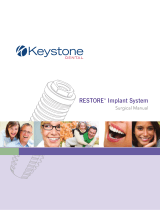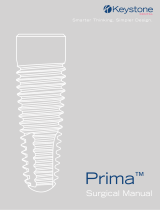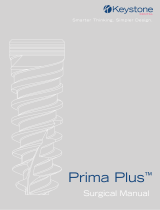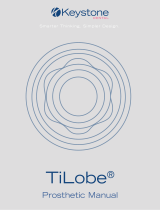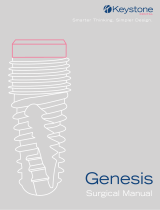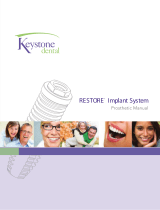Page is loading ...

1/3
en - Axiom® BL X3 Implants - Instrucons for Use
K
A Anthogyr
2237 Av. André Lasquin
74700 Sallanches – France
Phone : +33(0)4 50 93 78 60
www.anthogyr.com
Email : [email protected]
Validity Date : 2021-02
REF : 063IMPL-X3_NOT_EN
Index : A
1. Product descripon
Axiom® Bone Level X3 (Axiom® BL X3) implants
are part of the Axiom® Multi Level® system, an
implant concept which offers a range of endos-
seous dental implants of various designs (length,
diameter, thread profile, platform, etc.) and the
corresponding prosthetic parts, healing compo-
nents and ancillary instruments.
Axiom® Multi Level® implants are implants with
a BCP sanded bone attachment surface.
Axiom® Multi Level® dental implants can be
used after extraction or after the loss of natural
teeth to restore chewing function. The prosthet-
ic restorations available include single crowns,
bridges and partial or full dentures, which are
connected to the implants via the corresponding
abutments.
These instructions for use apply to the following
dental implants:
Axiom® BL X3 implants
A cover screw is supplied with the implant inside
the packaging cap
Materials:
Titanium-6aluminum-4vanadium alloy:
2. Intended use
Axiom® BL X3 implants are intended for the
replacement of missing tooth roots, and enable
the stabilisaon of removable dentures, the
xaon of single-unit or mulple-unit dentures
or the stabilisaon of removable dentures.
3. Indicaons
Axiom® BL X3 implants can be used in one-stage
or two-stage surgery. They are suitable for im-
mediate or delayed implantaon in the maxillary
or mandible area of parally or totally edentu-
lous paents, to restore the funcon of missing
teeth. Axiom® BL X3 implants are designed for
immediate use in suitable clinical situaons
(sucient primary stability and appropriate
occlusive loads).
4. Clinical benefits
- Restoraon of mascatory funcon
- Aesthec restoraon
5. Paent type and intended user
Axiom® BL X3 implants are intended for use with
partially or totally edentulous adult patients who
do not present any of the conditions mentioned
in the "Contraindications" section.
Axiom® BL X3 implants must be used by a sur-
geon trained in dental implantology.6.
6. Contre-indicaons
Axiom® BL X3 implants with a 3.4 mm diameter
are not suitable for single-unit tooth restora-
tions in the molar sector.
- Allergy or hypersensivity to chemical com-
ponents in the materials used and menoned in
the “Product descripon” secon.
- Absolute contraindicaons: serious diseases
(tumours, heart disease, etc.), metabolism disor-
ders, uncompensated haematologic diseases,
drug addicon, alcoholism, psychosis, funconal
disorders, xerostomia, immune deciency, leu-
kocyte disorder, local or systemic treatments
(steroid, ancoagulant, chemotherapy or radia-
on therapy, etc.).
- Relave contraindicaons: bruxism, occlusal
stress, parafuncon, unfavourable bone anato-
my, pregnancy, growth not nished, insucient
oral hygiene, smoking lack of movaon or co-
operaon, irradiated bone, uncontrolled perio-
dontal disease, oral infecons or inammaons.
- Localised contraindicaons: Excessive resorp-
on and/or insucient bone quality, local radic-
ular residues.
7. Warning
Implant surgery is a complex dental procedure.
Incorrect techniques can cause implant failure
and/or loss of bone support.
Appropriate training and qualification and a
good knowledge of surgical techniques with
Anthogyr products are required. Anthogyr offers
specific training.
8. Cauon/Precauons
Clinical use:
Single-use devices: do not reuse or re-sterilise.
Risk of contamination and risk of alteration of
the functional surfaces.
It is important to perform a pre-clinical assess-
ment and treatment plan that takes into account
the anatomical constraints of the future restora-
tion.
Do not use an implant after the expiry date indi-
cated on the packaging.
Safety information regarding magnetic reso-
nance imaging (MRI):
The safety and compatibility of Anthogyr devices
that remain in the patient’s body have not been
evaluated in the magnetic resonance (MR) envi-
ronment. They have not been tested for heat
build-up, migration or artefacts in MR environ-
ments. The safety of Anthogyr devices in an MR
environment is unknown. Performing an MRI
examination on a patient wearing such a device
may result in injuries.
9. Eets secondaires indésirables
The clinical outcome of dental treatment is influ-
enced by multiple factors. The following residual
risks and possible side effects are related to the
use of Axiom® BL X3 implants and may lead to
additional dental treatment at the dental prac-
tice: swelling, haematoma, risk of swallowing/
inhaling small parts during the procedure, pho-
netic problems, pain, hypersensitivity/allergic
reactions, inadequate function or device failure
(mobility, loss of integrity), esthetic problems,
gingival injuries, damage to existing dentition,
bone damage, loss of marginal bone, hyperplas-
ia, exfoliation, dysesthesia, post-surgical pares-
thesia, perforation of sinus or alveolar plates,
systemic or local infection (including peri-
implantitis, periodontitis, gingivitis, fistula), local
or systemic infections including bacterial endo-
carditis.
10. Compability informaon
Anthogyr implants and prosthec components
are available in a wide variety of conguraons.
Only Anthogyr parts that are compable with
the implant connecon are suitable for use. For
more informaon, please refer to the manuals
listed in the “Further informaon” secon.
An Axiom® BL implant can be made compable
with an Axiom® TL implant through the use of an
InLink® abutment.
11. Cleaning and disinfecon
Axiom® BL X3 implants are supplied sterile
(GAMMA sterilisation) and are intended for
single use. Do not clean or sterilise the implants.
Cleaning, disinfection and sterilisation can com-
promise the essential material and design fea-
tures of the implants and result in device failure.
12. Sterilisaon
Anthogyr dental implants are supplied sterile.
The intact sterile packaging protects the steri-
lised implant from external contamination and,
if stored properly, guarantees sterility until the
expiry date. When removing the implant from
the sterile packaging, asepsis rules must be fol-
lowed. The sterile packaging must not be
opened before the insertion of the implant.
Check that the sterile packaging of the device is
not damaged before opening it. Do not use im-
plants from damaged sterile packaging. It is rec-
Chemical
components
Composion:
% (mass/mass)
Aluminium 5.50 to 6.50
Vanadium 3.50 to 4.50
Others (Fe, O, C, N, H) Total 0.53
Titanium Residual
Type
of implant
Type of
connection
Compatible
component
Axiom® BL X3 Conical Axiom® BL
Compable instruments
Axiom® BL implant screwing instruments in-
cluded in the surgical kit (grey)

2/3
en - Axiom® BL X3 Implants - Instrucons for Use
ommended to have a replacement implant read-
ily available for use.
Anthogyr declines all responsibility for re-
sterilised implants, regardless of who carried out
the re-sterilisation or the method used. Do not
use a previously used or unsterile implant under
any circumstances. If the original packaging is
damaged, Anthogyr will not accept the return of
the content.
13. Protocol for use
Refer to the brochures listed in the “Further
informaon” secon for detailed step-by-step
instrucons.
Step 1: Preoperative planning
The type, diameter and length of the implant, as
well as the number of implants to be used and
their positioning, must be determined in ad-
vance, taking into account the patient’s anatomy
and the oral environment.
For this purpose, use the X-ray templates availa-
ble in the range or a digital library
Step 2: Implant bed preparation
→ Mark the site with a pointer drill or a round
bur.
→ Each site should be prepared using a progres-
sive sequence of drilling diameters in accord-
ance with the implant diameter and the bone
density. Make sure never to exceed the depth of
the planned drilling: presence of depth marks on
each rotating instrument or use of drills with a
stop or a contra-angle fitted with a stop system.
Please refer to the “step-by-step” guidelines
listed in the “Further information” section.
Avoid overheating the bone when drilling and
tightening the implant to reduce the risk of bone
loss during the osteointegration phase. The risk
of overheating the bone can be reduced by using
irrigation and by controlling the torque.
Step 3: Removing the implant from the packag-
ing
The implant is packaged in a cardboard box with
sterile packaging consisting of a sealed blister
pack and a capped tube.
→ Remove the blister from the cardboard box
outside of the sterile field.
→ Open the seal without touching the inside of
the blister.
→ Let the capped tube gently fall on the sterile
field.
Warning: All handling should be done so as to
avoid direct contact with the exterior surface of
the implant. When handling the implant, be very
careful not to drop it in the patient’s mouth.
The implant is movable once the tube and stop-
per have been opened. Make sure to keep the
tube upright when handling, with the implant
access pointing upward.
→ Open the packaging with one hand
→ Use the corresponding implant wrench or
mandrel to pick up the implant directly.
1. Press the packaging on the indicated areas to
immobilise the implant
2. Connect the implant tightening instrument
into the implant
Ensure that the instrument is sufficiently en-
gaged in the implant connection before remov-
ing it from the packaging, to do this, check that
the laser marking is no longer visible.
3. Release the packaging to free the implant
4. Remove the implant from the packaging
Replace the implant in the packaging during
surgery if necessary.
1. Position the implant between the packaging
sheets
2. Press the packaging on the indicated areas to
immobilise the implant
3. Disconnect the implant tightening instrument
from the implant
4. Release the packaging
Step 4: Inserting the implant
PLACEMENT USING A CONTRA-ANGLE:
→ Adjust the output speed of the contra-angle
to the recommended speed of 15 rpm.
→ Using the contra-angle, screw the implant
into the channel to the desired depth. The Axi-
om® BL X3 surgical protocol provides for a 0.5
mm subcrestal positioning of the implant. Im-
plant wrenches and mandrels have markings for
the vertical positioning of the implant relative to
anatomical structures.
→ At the end of the screwing process, orient the
implant trilobe as closely as possible in the ap-
propriate direction, depending on the desired
prosthetic restoration and the situation in the
mouth. To do this, implant wrenches and man-
drels have 3 sides, each of them represented by
a visual mark on the instrument’s body.
Warning: Check the tightening torque frequently
to make sure it does not exceed 80 N.cm. You
can always untighten and retighten to reduce
screw pressure.
MANUAL PLACEMENT:
Using the ratchet wrench (available in the kit):
→ Manually pre-tighten the implant into the
implant channel using the implant wrench or
implant manual screw wrench.
→ Assemble the surgical ratchet wrench
→ Screw the implant into the channel to the
desired depth. The Axiom® BL X3 surgical proto-
col provides for a 0.5 mm subcrestal positioning
of the implant. Implant wrenches have markings
for the vertical positioning of the implant rela-
tive to anatomical structures.
→ When tightening, orient the implant trilobe
as closely as possible in the appropriate direc-
tion, depending on the desired prosthetic resto-
ration and the way it is situated in the mouth.
Implant wrenches have 3 sides, each with a visu-
al mark corresponding to a trilobate connection
for an implant.
Using the universal surgical instrument:
The universal surgical instrument can be used in
the anterior maxillary area to control and guide
the insertion of the Axiom® BL X3 implant along
the implant axis.
→ Remove the implant from the packaging us-
ing the trilobed tightening mandrel.
→ Screw the implant into the channel to the
desired depth. The Axiom® BL X3 surgical proto-
col provides for a 0.5 mm subcrestal positioning
of the implant. Trilobed tightening mandrels
have markings for the vertical positioning of the
implant relative to anatomical structures.
→ At the end of the screwing process, orient the
implant trilobe as closely as possible in the ap-
propriate direction, depending on the desired
prosthetic restoration and the situation in the
mouth. To do this, implant wrenches and man-
drels have 3 sides, each of them represented by
a visual mark on the instrument’s body.
Warning: When inserting the implant with the
surgical ratchet wrench or universal surgical
instrument, control of the tightening torque is
not possible. However, the verification of the
torque using a surgical dynamometric wrench to
tighen the implant is possible.
A torque to high can damage the connection.
Untighten and retighen to reduce the screw
pressure if needed..
Step 5: Soft tissue treatment, wound closure
→ Select the appropriate healing component for
the treatment
→ Refer to the instructions for use for healing
components.
Use of the cover screw:
→ Remove the cover screw from the implant
packaging cap
1. Connect the manual surgical wrench to the
screw.
2. Pull to release it.
→ Tighten manually, without forcing the cover
screw in the implant.
→ Suture to begin the integration period.
14. Healing phase
The healing period required for osseointegration
varies considerably and depends on the individu-
al patient and treatment.
It is the sole responsibility of the surgeon to
decide when the implant can be loaded. If tem-
porary components are used during the healing
phase, they must be placed in sub-occlusion
15. Further informaon
For more specific information on the Axiom® BL
X3 implants, please refer to:
- Axiom® BL X3 Surgical User Guide (AXIOM-
X3C_NOT)
- Axiom® Multi Level® Prosthetics User Guide
(AXIOM-MLP_NOT)
Subject to the availability of the European Medi-
cal Device Database (EUDAMED), the summary
of safety and clinical performance characteristics

3/3
en - Axiom® BL X3 Implants - Instrucons for Use
(SSCP) is available at https://ec.europa.eu/tools/
eudamed.
16. Storage
Store these products in a clean, dry area, at
room temperature. Improper storage may com-
promise the essenal characteriscs of the ma-
terials and design, which may lead to device
failure.
17. Waste treatment
Waste resulng from the intervenon
(packaging, part extracted, etc.) must be han-
dled as medical waste under the responsibility of
the user.
18. Informaon paent
Le paent doit accepter un suivi médical régulier
et doit consulter son médecin en cas de modi-
caon inaendue des performances de la re-
constuon prothéque. L’aenon du paent
doit être arée sur la nécessité d’une hygiène
buccale régulière. Le paent doit être informé
d'être vigilant pendant les premières semaines
suivant la chirurgie. Les informaons de traçabi-
lité sont à disposion du paent via les é-
quees détachables sur le disposif.
19. Notes
The praconer must have the necessary
knowledge to pracce dental implantology and
must be familiar with the handling instrucons
for Anthogyr products as described in this docu-
ment in order to use Anthogyr products safely
and in accordance with their instrucons for use.
Anthogyr products must be used in accordance
with the manufacturer’s instrucons for use. The
dental surgeon is solely responsible for the prop-
er use of Anthogyr products in accordance with
their instrucons for use and to determine
whether the product is suitable for the individu-
al paent’s situaon.
Anthogyr products are part of a complete range
and must be used in combinaon with the corre-
sponding original components and instruments
distributed by Anthogyr, its parent company and
any aliates or subsidiaries of the parent com-
pany (“Straumann”), unless otherwise specied
in these instrucons for use. The use of third-
party products not distributed by Anthogyr voids
any warranty or other obligaon, express or
implied, of Anthogyr.
Any product-related issues must be reported to
the local Anthogyr organisaon together with
the product in queson. In the event of a serious
incident, the user must le a report with the
local Anthogyr organisaon and the appropriate
competent authority in accordance with local
regulaons. Anthogyr also oers an online com-
plaint service in the countries concerned.
20. Validity
The publicaon of this document supersedes
and replaces all previous versions.
Anthogyr all rights reserved.
Anthogyr® and/or other trademarks and logos of
Anthogyr® menoned herein are trademarks or
registered trademarks of Anthogyr.
21. Availability
Some components of the Anthogyr implant sys-
tem are unavailable in certain countries.
22. Symbols
The following table describes the symbols that
may be printed on the packaging label. Please
refer to the label on the packaging for the appli-
cable product symbols.
Symbol Description of symbol Source of
symbol
A Manufacturer ISO 15223-1
B Date of manufacture ISO 15223-1
N Catalogue number ISO 15223-1
O Batch code ISO 15223-1
P Serial number ISO 15223-1
D Consult instructions for use
or consult electronic instruc-
tions for use
ISO 15223-1
b Medical Device ISO 15223-1
e Unique Device Identifier ISO 15223-1
G CE marking - compliance with
current regulations
Direcve
93/42/CEE
——————
MDR (EU)
2017/745
i GOST-R logo for certification
of the Russian Federation
]only FDA certification logo
21 CFR
801.109(b)
(1)
V Use-by date ISO 15223-1
c Single sterile barrier system ISO 15223-1
a Single sterile barrier system
with protective packaging
inside
ISO 15223-1
S Sterilized using irradiation ISO 15223-1
? Do not resterilise ISO 15223-1
F Non-sterile ISO 15223-1
g Sterilizable in a steam steriliz-
er (autoclave) at temperature
specified
ISO 15223-1
ù Non sterilizable in a steam
sterilizer (autoclave) at tem-
perature specified
Anthogyr
X Do not use if packaging is
damaged and consult instruc-
tions for use
ISO 15223-1
Y Keep away from sunlight ISO 15223-1
W Do not re-use. ISO 15223-1
E Caution ISO 15223-1
f Contains hazardous substanc-
es ISO 15223-1
/






